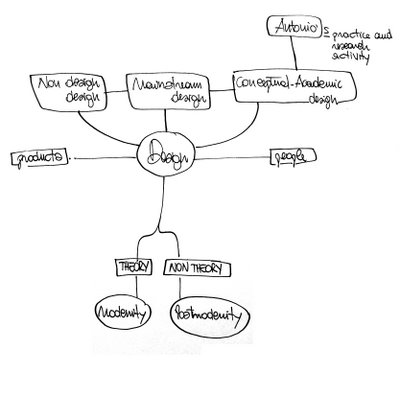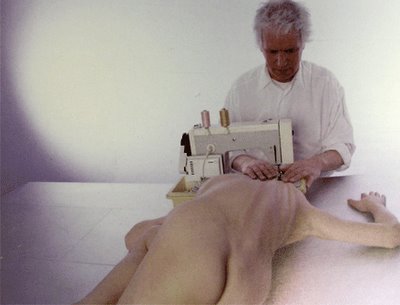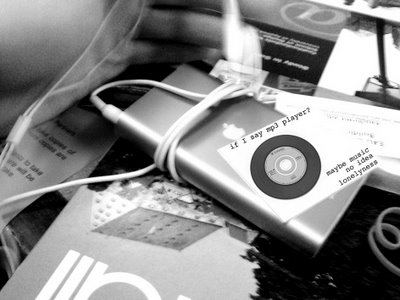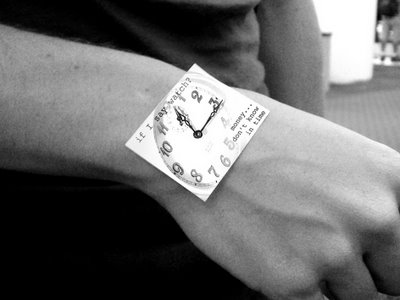Tuesday, April 25, 2006
WATCH: art?
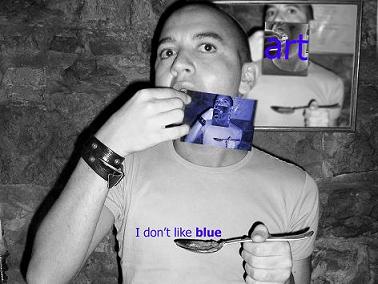

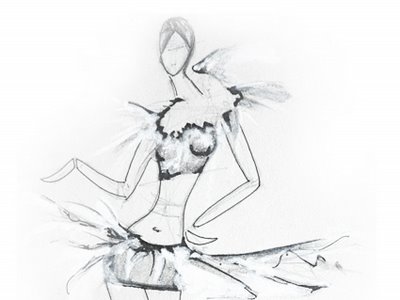

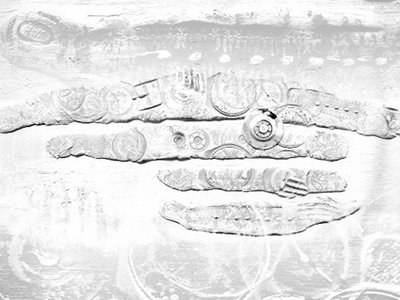
MP3: think?
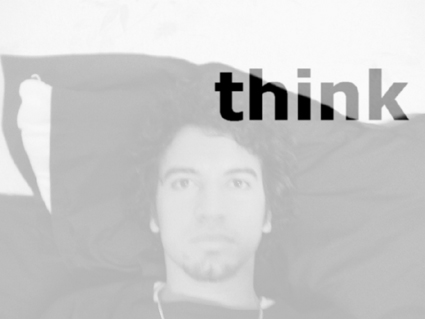
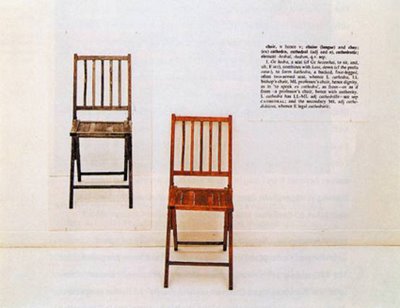



Other times I prefer thinking about the process, the idea, the concept, not too much about the material aspect of the product. In the images above I put what for me are examples. Kosuth and his conceptual art is an example of how important is just the idea of something, the concept behind and how this can stimulate reactions in the observer. I am fascinated by the approach of the Royal College of Art in London, because in it I can see the effort they are looking for the depth of design. The idea of the mp3 player is just the materialization of the icon of the folder everybody has on their desktop, as necessity to store our different datas and touch them, and keep them in a place at home as we used to do with tape recorder.
Monday, April 24, 2006
MOBILE PHONE: style?
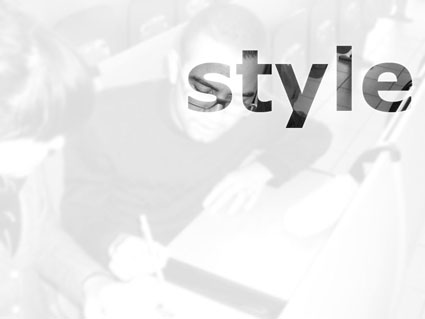
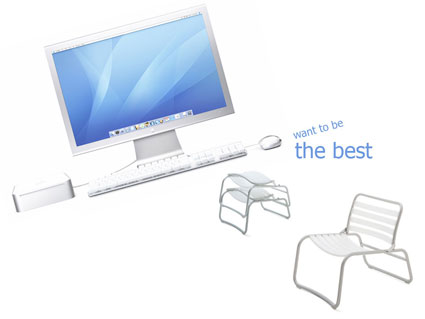
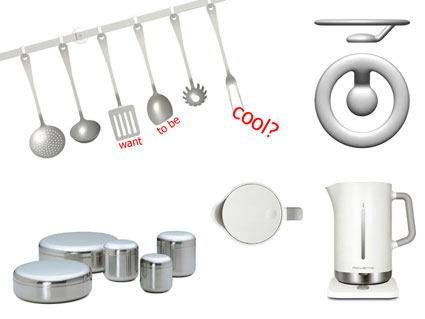
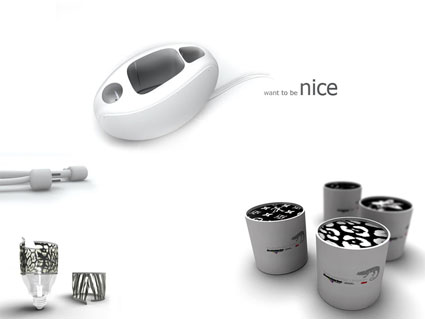

In designing the mobile phone I want to respect a coherent style balancing between my ideas and what the contemporary scene of design shows. My being honest consists in admitting that some of my choices are dependent to what I consider contemporary design and to what I think people would appreciate, avoiding my total freedom, as proof that design differs from art.
Sometimes when I'm really worried about the style of my design, my first strength is in doing something that people would love, this is part of design and a good opportunity to think about the business of design.
A trend in contemporary design is minimalism, and colours like withe and satinate silver seem to be the right mix in creating something with a present value.
Usually in my design process I feel the due to respect these trends, trying to find balance between my ideas, my tastes, my style and what the contemporary scene would appreciate.
Wednesday, April 12, 2006
rethinking about design methods
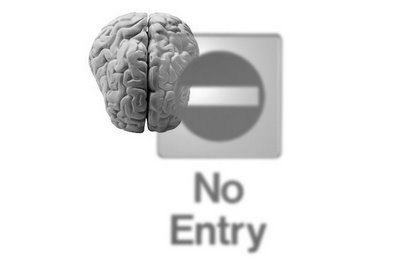
o When I first refused to study design methods
o Design method?
o Art or Design
o Codes
o No-honest and honest inspirations in my design
When I first refused to study design methods
The first time I heard the espression “design methods”, I did not want to hear anything about it. I refused to think that it would be possible to stereotype in such a personal matter, or even worst, I thought, “No way! I am not going to read about the design methods of other designers… I’m fine with mine! At least I would like to learn about some technical skills like using computers, drawing, prototyping…”
In January I hade my first bad mark, and I refused to compromise my idea to improve the grade.
Coming to Melbourne I had the opportunity to study again in a course called “Design Methods” and there was the possibility to substitute the course from Politecnico with the course from RMIT, without damaging my career and my marks. While reading I discovered that what I was thinking was not totally inappropriate. I was wrong in considering the course superficial and rethorical. I then found interesting readings about the course. There are some “honest” expressions that I would like to cite:
“One of the greatest excitements in being a designer must surely be the vicarious thrill of being the eminence grise behind the familiar products of industry and commerce, knowing that a certain colour, shape, detail or function is such a way because that is how you wanted it.”(Kenneth Grange, 1982).
Usually the differences in designs between various designers and artists are the characters and careers and their individuality. Here some words from the introduction of Objects of Desire Design and Society since 1750 (1986) written by Adrian Forty, that illustrate this difference,
“…Chippendale’s furniture designs might be said to differ from Sheraton’s because Chippendale and Sheraton were different people, each with his own artistic ideas. It is when we try to identify the reasons for these differences that we run into difficulties, wich become more acute when we consider not simply the work of individuals but the appearance of whole classes of goods involving a multitude of designers: why, for example, was office equipement designed in the 1900s universally different in appearance from that produced in the 1960s? Putting this down to differencies in artistic temperament would be ridiculous…
Design method?
The term “design method” is an attempt to define a deep process of our mind. Trying to give a definition of design methods or trying to depict a stereotype of these processes should be considered impossible. In the most cases it is considered impossible to try to define this “primitive concept” but in other cases various theorists (they are not always designers) try to find a solution or a comprhensive explaination of the words “design methods”. In its simplest aspect the term “design” refers to every kind of process that aids in creating a building, poetry, paintings, journey’s, and parties. We talk of projects when we act and make decisions thinkig about the results.
Design comes from the latin word “designare” that means drawing,doing signs by acting, but we relate the word design to the word project, that comes from the latin word projectare JECTARE means to launch PRO means forward.
Today the word design has acquired a particular meaning influenced by historical factors such us the industrial revolution or the years 1950’s and 1960’s “…when the frst literature on design methods began to appear in most industrialized countries…” John Chris Jones (1980).
Many people know what design ( I’m talking about the process not the term) is and we could say many people could be designers. The skills used in being a designer are not related to the skill set required for science or art, but our way of thinking and finding solutions concludes that, a design method is a thought, it is a process of our mind, it is something that we cannot see we cannot touch, and we choose various instruments to visualize what is going on in our brain. We use codes to express these thoughts. These codes include gestures, drawings of gestures with our pencil, words as gestures of our mouth, dance as gestures of our body.
“A bee puts to shame many an architect in the construction of her cells but what distinguishes the worst of architects from the best of bees is this, that the architect raises his structure in imagination before he erects it in reality. At the end of every labour process we get a result that already existed in the imagination of the labourer at its beginning”
Karl Max (1818-1883)
Art or Design
As a designer my first strenght is in trying to express my thoughts , my ideas with universal codes, with languages so that everybody can understand. As an artist my first strenght is in trying to express myself . I can recognize when I’m “doing” art just for me or when I am “doing design” to comunicate something. Designing is not just about solving problems, we talk about design the very first moment we use codes to make others understand our ideas, so that we are not the only ones that understand. Design is recognised as being a useful art form however it can also be identified as useless. I don’t think of design as a kind of useful art form because this assumes that all designs should be good designs. I believe art differs from design. An artist can choose to do something that is not comprehensible to anyone. He can choose to do something with a code invented by himself and therefore nobody else can read it.
I often read that design differs from art because of its utility, but I know a lot of useless products that sell better than usefull ones. This means design is about comunicating something with or without a goal. It is a choice anyway to have “no-goal”. This could be the solution to our design. The biggest complication is concerned with the fact that every man has different thoughts. This in turn means every single man has different designs, and even if we try to use the same codes it will be impossible as there will always be some of the mind processes missing.
“True, the designer may sketch or draw profusely but his drawings are by no means totaly explicit about waht is going on in his head. Unfortunately for those who would wish to draw a map therefore most of the route remains hidden, for it is what goes on in the designer’s mind which really matters.”
Bryan Lawson (1986).
Codes
The best method to express our ideas, is through choosing the code that we know best and trying to encode our designs with them. An example using the language-code is by thinking about narrative technique as a “stream of consciousness” or other kinds of interior monologues as an attempt to write on the page. These things are really going on in our mind. Trying to use a code that someone else could understand (design), like a very famous, informal painter or a sculpturer from DADA, would not think about what they are saying (art). Someone else could try to interpretate their thinking and the very first thing they could say would be a reaction or a revolution just because they are using a new and different code from all the other codes. We would say it was incomprehensible for us to try to give it meaning, transforming art in design, relating art to social or political matters or even worst to business, not caring too much about the real process of mind of the artist.
Sometimes I would like to hear expressions like this: “Picasso painted Guernica in that way that day becouse he was drunk. Yes he was trying to express the hunger about the bombing of Guernica by Franchisti, but in that precise moment he was drunk, and when he saw the picture he liked it”
I have given this example, because I want to say that somethimes theorists try to give definitiosn about design methods and they are not even designers. While I was reading something that I found really interesting in the book How Designers Think the Design Process Demystified written by Bryan Lawson (1986). Even if I don’t agree with him in some aspects, Lawson, in my opinion, is more honest than other writers. This is evident in some of his following expressions;
“In the end perhaps design must be learnt rather than taught.”
“It is obviously essential for a designer to have a good understanding of the technologies relevant to his field, but this alone will not make a successful and productive designer.”
“For many of the kinds of design we are considering it is important not just to be technically competent but also to have a well developed aesthetich appreciation... The designer must understand our aesthetic experience, paticularly of the visual world, and in this sense his work may seem not unlike that of an artist.”
“… he is judged by the solutions he produces rather than the methods by wich he arrives at those solutions.”
“Most of the maps of the design process which we have looked at seem to resemble more closely the non-designer, scientist approach than that of the architect: first analysis and then synthesis.”
“There is a danger with this approach, since writers on design methodology do not necessarily always make the best designers, and taht must obviously include this author too.It seems reasonable to suppose that our best designers are more likely to spend their time designing than writing about methodology.”
No-honest and honest inspiration in my design
The final solution is the really end of our design, nobody could know the real inspiration or how our mind was thinking in that determinate moment of creation, it is up to us being honest or not, in the end the most important thing is being conscious of our choices.

The image above is about “vicky” a concept dishwasher presented in a work simulation experience with Whirlpool Europe ( Cassinetta di Biandronno, Varese, Italy, october 2004). In this case I sayd inspiartions of my design were key words as: nature, organic, technology, witheness and that the shape was inspired from the design of natural spears, that was in part true, but I found the real inspiration for the shape while I was on the train going from Como to Milan looking at a mountain’s profile.
The image above is about “giara” a concept waste-paper bin for beaches in a work simulation experience with EB&C Centro Ricerche Enrico Baleri ( Milano, Italy october 2005). In this case the true inspiration for my design was from mediterranean elements and in particular ancient greek anphoras used in the past to store the wine.
Bibliography
“Kenneth Grange at the Boilerhouse, An Exhibition of British Product Design”, The Conran Foundation Boilerhouse Project, Consultant Design Director to Wilkinson Sword Limited, 1982
“Design Methods by John Chris Jones Second edition with new prefaces and additional texts”, previously published as J. Christopher Jones, Design methods seeds of human futures, John Wiley & Sons, New York and Chichester, 1970 with eight reprintings between 1972 and 1982 and second edition 1980 pubblished by david Fulton Publishers, London, from 1987 to 1990.
“Objects of Desire design and society since 1750” by Adrian Forty,1986. Thames and Hudson.
“How Designers Think The Design Process Demystified, second edition” by Bryan Lawson, Butterworth Architecture, An imprint of Butterworth-Heinemann Ltd Linacre House, Jordan Hill, Oxford OX2 8DP, Bryan Lawson 1990
Sunday, April 09, 2006
mobile phones inspiration

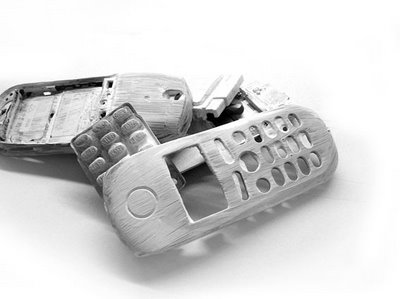

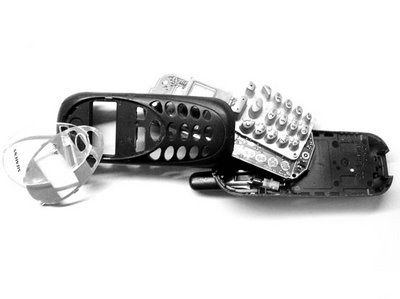 when I was deisigning the shape of the mobile I was just playing with broken cellulars I got in a shop, all the results are born from a process that I cannot describe, maybe the music I was listening to, or the weather of that day, this does not mean that my design it is a kind of abstract art or informal process I am trying with my mood of this particular momement to do something coehrent with my research. While and after the process of drawing or making, I wrote this, not too sure if it is honest or my attempt to justify my choices: "I would like to express the concept of : "something is missing" to enhance the immaterial idea of this product, the design would show something like a gap, a hole, as something has been cut out, thinking to redesign the shape staying in the middle between what is now on the market and what was in the past, putting in evidence the importance of the voice on one side of the product, while on the other everything is concerned to text and images ( keyboard, screen, camera...), paying particular attention on what it happens when this product is at home, and giving it a different and central identity as it was in the past,the texture of one surface will pay particular attention to the meaning of calling people and privacy... I would like to play on the idea of wire as we are tied or addicted to our mobile phones. I have been thinking about the three essential functions of cellulars, related to audio,images, and words. I was trying to imagine using both the sides of the mobile phone"
when I was deisigning the shape of the mobile I was just playing with broken cellulars I got in a shop, all the results are born from a process that I cannot describe, maybe the music I was listening to, or the weather of that day, this does not mean that my design it is a kind of abstract art or informal process I am trying with my mood of this particular momement to do something coehrent with my research. While and after the process of drawing or making, I wrote this, not too sure if it is honest or my attempt to justify my choices: "I would like to express the concept of : "something is missing" to enhance the immaterial idea of this product, the design would show something like a gap, a hole, as something has been cut out, thinking to redesign the shape staying in the middle between what is now on the market and what was in the past, putting in evidence the importance of the voice on one side of the product, while on the other everything is concerned to text and images ( keyboard, screen, camera...), paying particular attention on what it happens when this product is at home, and giving it a different and central identity as it was in the past,the texture of one surface will pay particular attention to the meaning of calling people and privacy... I would like to play on the idea of wire as we are tied or addicted to our mobile phones. I have been thinking about the three essential functions of cellulars, related to audio,images, and words. I was trying to imagine using both the sides of the mobile phone" mp3_ customization, music, styles
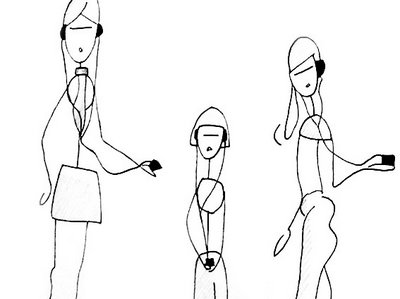

 I did not find any mp3 player broken to see how it is really done, but I know it is really simple , the only thing I tought during these days of self-questions was related to the power of identification in music and how today mp3 player are anonymous. I did not come out with the design yet but I know I want to do something related to the idea of different styles, I wrote these words after doing some sketch: designing the mp3 player I am thinking about the idea of customization dependent from the different styles of music, I would like to design little elements as materialization of the folders of the computer, maybe playng on te semiotic meaning of the icon on our desktop in this way we could store our mp3 and choosing the various folder as phisical element; I would like to play on the idea of multiple elemets as essential meaning of comunicating customization
I did not find any mp3 player broken to see how it is really done, but I know it is really simple , the only thing I tought during these days of self-questions was related to the power of identification in music and how today mp3 player are anonymous. I did not come out with the design yet but I know I want to do something related to the idea of different styles, I wrote these words after doing some sketch: designing the mp3 player I am thinking about the idea of customization dependent from the different styles of music, I would like to design little elements as materialization of the folders of the computer, maybe playng on te semiotic meaning of the icon on our desktop in this way we could store our mp3 and choosing the various folder as phisical element; I would like to play on the idea of multiple elemets as essential meaning of comunicating customization _inspiration for the watch's design





 the first thing I tought about time was: time means money, then I started playng with das and an old mechanism of a broken watch ( or better swatch) of mine, and I discovered how was nice impressing textures of 'time' on white clay, I tought it would be interesting thinking about this "impressions" of the moment, as defining time flux, I told to myself : what is time? it does exist? we use time to organize our life and to see the past and maybe the future and a watch? a product invented to mesure something invented too... the idea is centred about the moment of consumption of an object, the string of the watch as sign of consumption and time. The idea is about the power of time and watches to record events and signs, I was playng around the idea of money and fossils, would be nice to find a material as gum or another soft one that changes surface when it touches something, as if something is impressed on it, I was using das, or clay... time as recorder, impressing memories on surfaces, fossils... time as money...
the first thing I tought about time was: time means money, then I started playng with das and an old mechanism of a broken watch ( or better swatch) of mine, and I discovered how was nice impressing textures of 'time' on white clay, I tought it would be interesting thinking about this "impressions" of the moment, as defining time flux, I told to myself : what is time? it does exist? we use time to organize our life and to see the past and maybe the future and a watch? a product invented to mesure something invented too... the idea is centred about the moment of consumption of an object, the string of the watch as sign of consumption and time. The idea is about the power of time and watches to record events and signs, I was playng around the idea of money and fossils, would be nice to find a material as gum or another soft one that changes surface when it touches something, as if something is impressed on it, I was using das, or clay... time as recorder, impressing memories on surfaces, fossils... time as money...Thursday, April 06, 2006
inglobation, chameleon, technology, skin, surface...
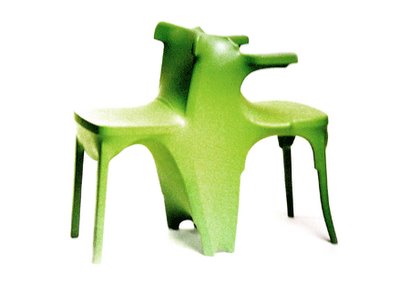 KOKON DOUBLE CHAIR, 1999
KOKON DOUBLE CHAIR, 1999  DIVISUMMA 18, 1972
DIVISUMMA 18, 1972 electronic printing calculator ABS plastic, melamine, rubber designer: Mario Bellini, b. 1935 Colletion: cooper-Hewitt, National Design, Museum Smithsonian Institution, 1986.99.41 manufacturer: Olivetti, Italy photography: Matt Flyn

tubes picture taken on Brunswick street (Melbourne) on monday 04-04-2006
reflections on fashionalble minds and consumerism
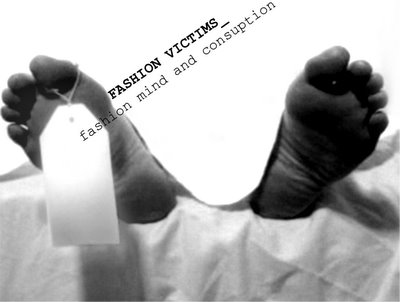 introduction
introduction I would like to quote Kennedy Fraser(1) from one essay appeared in 1976 in The New Yorker.
“… Many societes have been openly dominated by fashionable people, but our society is quitely permitting itself to be dominated and transformed by fashionable minds. The word “fashion” (with fashionable) isn’t heard much anymore, and even its successors “trend” and “style” have come to seem a little tasteless and passé. But fashion is everywhere around us just the same. It’s there wherever political strategies are planned, movies made, books pubblished, art exhibits mounted, critical columns turned out, dance danced, editorial policies formulated, academic theses germinated: wherever people think, speak, or create our shared forms of self-expression. Fashion is usually neither named nor noted but is simply the lens through wich our society perceives itself and mold to wich it increasingly shapes itself. This hidden, powerful, mental sort of fashion is thus worth taking stock of…”
abstract
We all want to look good, not only to ourselves but more so to other people. This whole preoccupation with looking good is the cornerstone of the entire fashion industry. We abide by certain norms on how we look or should we look.
This paper is an overview about fashion victims, who they are and how consumerism takes advantage from people’s insecureness about their way to look to other people.
“…A fashion victim is someone who follows trends slavishly, a person who is not necessarily captivated by the beauty of a new garment so much as the mere novelty of it and the social standing it conveys.In everyday life, the people we typically refer to as Fashion victims are tagged as such for one simple reason: they don’t look good…”(2)
keywords
fashion, mind, consumption
the meaning of the expression “fashion victim”
A fashion victim is someone obsessed by his image not just its own perception in itself, more about how they look like to other people. By wearing trends and brands, usually they are not worried about feeling confortable with their clothes with the risk to result ridiculous and with a bad taste in wearing them. Clothes and accessories or whatever people can perceive about you, belongs to the same idea of physical requisites: standards for height, proportions, weight and ideas of perfect beauty that we can see on fashion magazines, tv, cinema…
And what about the contropart of being fashion victim, the “trend” to be anti-fashion and the ostentation to do not follow trends and the paradox of the trend: to be not “trendy”? We would say, as an example, what is beauty? This opposite reaction could be seen in the beauty of Pidro Almodovar’s best actrees or in some ardvertising like the one from sisley, in witch a new reinterpretation of beauty try to feel the gap between real and hyperreal.
what people think a fashion victim is
If you try to do a research about what the term “fashion victim” means to
people you can hear various versions, someone is going to tell you that a fashion victim is someone that “suffers” by wearing something non natural or not confortable just cause it is not “appropriate” wearing something else, or even worst someone that damage his healt just to follow a trend.
Others say fashion victim is someone really obsessed in wearing brands, labels,a friend of mine from Canada call them label horses. In italy someone seems to be proud to define himself a fashion victim as conferming this need.
Examples of the first interpretation could be: ties we have to wear in really formal events, pointly ankle boots with a three-inch heel, young girls wearing spring clothes during the winter standing on the road trying to keep worm by pulling their thin coats around themselves, men shaving with wax their body? Trust me I’ve tried it hurts, what about Carrie Bradshaw from the tv series Sex and the City living in New York and spending more than half of her salary to by Manolo Blahnik shoes and saying “dolce dolce dolce” (sweet,sweet, sweet) holding her shopping out from the door of Dolce & Gabbana store in Manhattan, and then Victoria Bekham, Marhaia Charie and all the gossipy.
fashion and consumerism
The time when "fashion" was defined by French designers whose clothes could be afforded only by elite has ended. Now designers take their cues from mainstream consumers and creativity is channeled more into mass-marketing clothes than into designing them, so is a fashion victim the best customer a designer could dream? Or it is just about consumerism and compromises? Here some words I found interesting about this:
“…Why people buy things they don’t need?
Becouse they to need…”(3)
“…That is the simple answer to a profoundly challening question. Consumers buy things to satisfy a concrete, distinctly felt need. Many consumer marketers go little further than this: uncover the need target it in advertising, and voila, products get sold…”(3)
“…In the later decades of the twentieth century, essentials have captured far less of the consumers’ budget…”(3)
“…Today, over 40 percent of consumer spending is discretionary…”(3)
So consumerism takes advantage on people fears, dreams. As designer should I take advantage from post-adolescetn emotionally fragile girls, deisgning something they would be “crazy” about? Would be a victory in my career? Or just a mere strategy in trying to gain money or fame?
Giving an answer to this question would be easy for my, but when I try to put my self into the other side, in the world of “Non-fashion Victims” I feel a layer not just because I think I’m not a fashion victim but because when I see people so involved in being not fashion, or original, or strange, weird, rebellios I start thinking that they follows so strongly their own trend that maybe are fashion victims or we can say Non-fashion victims,but victims anyway!
PUNK from non-trendy to trendy
An example that I faced reading it is that one of the phenomeno PUNK generation, we are talking about the mid.1970s, P-U-N-K was a a violent reaction to the excesses of a once youthful hippie community that had regressed into the banal world of disco and rock star posturing, they were disgusted because they could not relate anymore to what they were seeing and hearing,fashion- and music-wise, punk became a lifestyle, a way of looking at things with critical eyes they wanted to undermine every known aesthetic cultural, social and political norm with their punk ethik…
The difficulty in finding an answer to my question lies in this paradox: we have two extreme example, on one side we were talking about fashion victims and all the negative aspects, then we were trying to answer to the problem talking about who is against trends and our “esagerated” example was to be PUNK.
Wich one is better? To be trends victim or to be anti-trends victm? The solution would sound as easy as possible: ignorance, people who doesn’t know does not care about what they look like, and this solution sounds even worste in my mind.
preveding trends
Actually agencies involved in social research are involved in searching new trends, trying to have a look around the world and seeing what is happening, their role could be discovering single cases around the world, interpreting these cases as probable future trends, and selling these research to fashion agencies or design studios. An example could be the Future Concept Lab(4) in Milan.
trying to find a solution
My answer will sound obvious, maybe non so common place as sayng “you should be yourself” I better say “you should be awere of who you are”
Are you a fashion victim? Are you against fashion?, I would not say you should be yourself just because I would justify who is ignorant, I admit you can be ignorant about trends, what’s the problem? But you should not be ignorant about yourself, I found the solution in being myself, someone who knows me could say that sometime I don’t act being myself in my totality, I would say this is part of being myself, I konw it.
So what if everybody is going to follows their trends with all the negative consequences? And even better what if I want to spend 800& to buy a Fendi bag? I’m a victim? Yes could be, but I permit it and in consenting it I’m not a victim anymore.
conclusions
So designing should not be a big problem, only a matter of doing, producing, selling something that can be appreciated as can dislike to people, and what about the strategy?
Now I am young I am just studying, it is too early for these compromises, maybe one day I will use strategies and I will be a “criminal” in designing, but I will be aware of that and hopefully my clients will be aware to be my favourite fashion victims, but for now I say I prefere designing expressing more my feeling and my ideas than thinking about the results in selling.
literature
1Fashionable Mind Reflection on Fashion by Kennedy Fraser published by Alfred A. Knope, inc.
2Fashion Victim Our Love-Hate Relationship with Dressing, Shopping, and the Cost of Style by Michelle Lee
3Why People Buy Things They Don't Need : Understanding and Predicting Consumer Behavior by Pamela Dazinger
4 www.futureconceptlab.com
Tuesday, April 04, 2006
STORMING: ethongraphic research? participatory design? and what about arbitrary stimulus?
 I decided to start my research receiving stimuls from people words and beahviors. I was just asking to someone: what if i say watch? writing the answers on a post_it and putting these notes on their bodies. I can say this research has been useful just to know something more about people reactions and not really to discover something extraordinary about mobile phones. When I ask a question about product to someone I can see various reactions, someone tryes to say something that sounds important and someone else want to appear spontaneous. My experience (the one about putting notes on their bodies) was a play and they usually were loughing at me. I received just stimulus as the ones I can receive walking on the street of a new city like Melbourne, or going to the theatre. I'm going to create three posts asking people to insert words about my three products, maybe I can get more inputs.
I decided to start my research receiving stimuls from people words and beahviors. I was just asking to someone: what if i say watch? writing the answers on a post_it and putting these notes on their bodies. I can say this research has been useful just to know something more about people reactions and not really to discover something extraordinary about mobile phones. When I ask a question about product to someone I can see various reactions, someone tryes to say something that sounds important and someone else want to appear spontaneous. My experience (the one about putting notes on their bodies) was a play and they usually were loughing at me. I received just stimulus as the ones I can receive walking on the street of a new city like Melbourne, or going to the theatre. I'm going to create three posts asking people to insert words about my three products, maybe I can get more inputs. Sunday, April 02, 2006
3. choice

It is not about doing a better work of Nokia, Swatch or Apple, it is just to express what my research is in a practical and tangible way.
o THEORISTS (PHILOSOPHERS, THINKERS, DESIGNERS, ARTISTS...)
Trying to associate their thinking with various images of human production or behavior.
o FOCUS
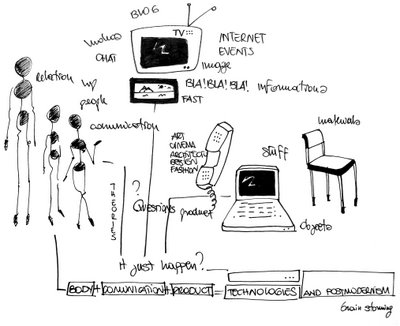
“One of the greatest excitements in being a designer must surely be the vicarious thrill of being the eminence grise behind the familiar products of industry and commerce, knowing that a certain colour, shape, detail or function is such a way because that is how you wanted it.”(Kenneth Grange at the Boilerhouse, An Exhibition of British Product Design, The Conran Foundation Boilerhouse Project)
As practical research I want to design examples of products while continuing my readings and putting on evidence the influences that my research could have on my personal design process. I want to enrich the practical aspect of my enquiry focusing my approach in doing prototypes of little products in particular technologies related to the body, as an interesting field related to the theory of modernism and post-modernism, it would mean for me explore the modern meaning of technologies and their link to artifacts, as a fusion between communication and products (interfaces, graphics, interaction but also shapes, materials, ergonomics…) a link that really match with the contrasts of postmodernist theories.
“As an industrial designer I sometimes think how lucky we are to design simpler goods and have the chance to model them first, then see them proved in one or more prototypes.”
Kenneth Grange
o IDEA-MAP
